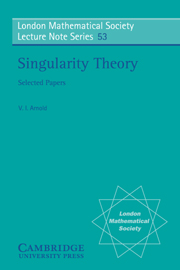Book contents
- Frontmatter
- Contents
- Introduction
- Singularities of smooth mappings (Volume 23, 1968)
- On matrices depending on parameters (Volume 26, 1971)
- Remarks on the stationary phase method and Coxeter numbers (Volume 28, 1973)
- Normal forms of functions in neighbourhoods of degenerate critical points (Volume 29, 1974)
- Critical points of smooth functions and their normal forms (Volume 30, 1975)
- Critical points of functions on a manifold with boundary, the simple Lie groups BK, CK, and F4, and singularities of evolutes (Volume 33, 1978)
- Indices of singular points of 1-forms on a manifold with boundary, convolution of invariants of reflection groups and singular projections of smooth surfaces (Volume 34, 1979)
Introduction
Published online by Cambridge University Press: 05 April 2013
- Frontmatter
- Contents
- Introduction
- Singularities of smooth mappings (Volume 23, 1968)
- On matrices depending on parameters (Volume 26, 1971)
- Remarks on the stationary phase method and Coxeter numbers (Volume 28, 1973)
- Normal forms of functions in neighbourhoods of degenerate critical points (Volume 29, 1974)
- Critical points of smooth functions and their normal forms (Volume 30, 1975)
- Critical points of functions on a manifold with boundary, the simple Lie groups BK, CK, and F4, and singularities of evolutes (Volume 33, 1978)
- Indices of singular points of 1-forms on a manifold with boundary, convolution of invariants of reflection groups and singular projections of smooth surfaces (Volume 34, 1979)
Summary
Professor Arnold is well known for his researches on a variety of topics in pure and applied mathematics, but perhaps no field owes more to him than singularity theory. In this volume are collected 7 survey articles of his on singularity theory that have appeared over the last decade. The first of these, written at a time (1968) when the subject was rapidly opening up, remains an excellent general introduction to the field as a whole.
However the core of the volume, consisting of 3 articles which appeared in 1973–75, consists of an account of the classification of critical points of smooth functions, and of the reinterpretations of a key class of functions (those with normal form depending on at most one parameter) – in relation to Lie groups, spherical and hyperbolic triangles, and definiteness of the intersection form – obtained by Arnold and his students during that period. Together, these results constitute one of the most beautiful discoveries in mathematics in recent years: and the further detailed study of these classes of singularities has revealed at each stage unexpected and rich structure.
Although Arnold does not shrink from describing the detailed calculations from which these lists are derived (the articles contain extensive – though not complete – sections of proofs) the surveys are far from being dry lists. He shows how a problem on estimating oscillatory integrals led him to start classifying functions; and by defining and computing an invariant (the ‘Arnold index’) applies the classification back to the original problem. In another paper, he relates the singularities of functions to those of projections of Lagrangian (and Legendre) submanifolds, and to the structure of caustics. The analysis of singularities of evolutes led to an extension of the work, in which singularities on the boundary of a manifold are investigated: an extension which in many ways completes the pattern set by the original.
- Type
- Chapter
- Information
- Singularity Theory , pp. 1 - 2Publisher: Cambridge University PressPrint publication year: 1981



